
Prof. Mrityunjoy Chakraborty, FNASc, FNAE
INAE Chair Professor (2019-2021)
Professor
Department of Electronics and Electrical Communication Engg.
Indian Institute of Technology (IIT), Kharagpur
Biography:
Mrityunjoy Chakraborty obtained Bachelor of Engg. from Jadavpur university, Calcutta, Master of Technology from IIT, Kanpur and Ph.D. from IIT, Delhi. He joined IIT, Kharagpur as a faculty member in 1994, where he currently holds the position of a professor in Electronics and Electrical Communication Engg. The teaching and research interests of Prof. Chakraborty are in Digital and Adaptive Signal Processing, VLSI Signal Processing, Linear Algebra and Compressive Sensing. In these areas, Prof. Chakraborty has supervised several graduate theses, and carried out carried out independent as well as sponsored research.
Prof. Chakraborty is currently a senior editorial board (SEB) member of the IEEE Signal Processing Magazine. Earlier, he had been an Associate Editor of the IEEE Transactions on Circuits and Systems, part I (2004-2007, 2010-2012) and part II (2008-2009), apart from being a member, SEB of the IEEE journal of Emerging Techniques in Circuits and Systems (2016-2017), Chair of the DSP Technical Committee (TC) of the IEEE Circuits and Systems Society (2016-2018), a guest editor of the EURASIP JASP and special issues of TCAS-II, track co-chair (DSP track) of ISCAS 2015-2019, TPC co-chair of IEEE SIPS-2018, special Session Co-Chair of DSP-18, Gabor track chair of DSP-15, and a TPC member of ISCAS (2011-2014), ICC (2007-2011) and Globecom (2008-2011). Prof. Chakraborty is a co-founder of the Asia Pacific Signal and Information Processing Association (APSIPA), has been a member of the APSIPA BOG (2013-2016) and also, served as the chair of the APSIPA TC on Signal and Information Processing Theory and Methods (SIPTM). He has also been the general chair of the National Conference on Communications – 2012, 2020.
Prof. Chakraborty is a fellow of the National Academy of Sciences, India, and also of the Indian National Academy of Engineering (INAE). Recently he received the prestigious Chair Professorship of the INAE. During 2012-2013, he was selected as a distinguished lecturer of the APSIPA.
Title: THE CORDIC ALGORITHM
Abstract:
The CORDIC (Coordinate Rotation Digital Computer), originally proposed by a mathematician named Volder in 1957, is an iterative algorithm to compute trigonometric quantities. In seventies, with the advent of FFTs, this found a ready usage in the hardware implementation of the twiddle factor based multiplications in the FFT. Subsequently, it found application in many other areas of signal processing and by eighties, it was recognized as an elegant tool for a wide array of signal processing jobs like FFT, DCT, Walsh-Hadamard transform etc., matrix operations like QR factorization, SVD, eigen-analysis etc. and also for multiplierless realization of digital filters. This seminar will present the CORDIC algorithm by developing it from basics and would consider its hardware implementation in terms of the so-called pipelined CORDIC units. It will conclude by showing some elegant applications of CORDIC.

Prof. Shekhar Verma
Professor,
Indian Institute of Information Technology - Allahabad
Biography:
Shekhar Verma has received his BTech, MTech and PhD from IIT BHU, Varanasi. He is currently working as professor in Information Technology at Indian Institute of Information Technology Allahabad. He has published more than 100 research papers in reputed refereed International Journals and more than 80 papers in international conferences. He has supervised 20 PhD scholars and handled many R&D projects. He is a member of the “Machine Learning and Optimization Group” at IIIT Allahabad. His research interests include dimensionality reduction, Manifold regularization, Privacy Preserving Machine Learning and Deep Learning techniques.
Title: Deep Learning in Wireless
Abstract
The ability of deep learning to extract feature and perform pattern recognition accurately from complex raw data makes it a potential candidate for design of wireless networks with large-scale topology and complex channel conditions. The wireless communication dynamics involving channel interference, traffic congestion, spectrum availability can be analyzed based on large amount based obtained from network parameters like delay, signal-to-noise ratio, throughput, probability of error etc. The talk delves on how deep learning can equip the wireless network with capability to handle and accept a large number of parameters, such as SNRs, channel holding time, collision rates, routing delay, packet loss rate, bit error rate, etc., and determine intrinsic patterns like congestion degree and occurrence pattern, interference alignment, hotspot distributions, etc. Such patterns can be used to perform the protocol controls at different layers. The talk also discusses some unsolved research issues in deep learning wireless networking like end to end congestion control, cross layer design, cognitive radio including effect implementation of distributed deep learning on wireless nodes that may have long-term dominant impacts

Prof. Amrutur Bharadwaj
Department of Electrical Communication Engineering
Indian Institute of Science Bangalore
Biography:
Bharadwaj Amrutur is a Professor in the ECE department and chairs the Robert Bosch Centre for Cyber Physical Systems - an interdisciplinary academic and research centre, at IISc. He obtained his BTech from IIT Bombay and is MS and PhD from Stanford University. His current research interests are in large scale IoT and Robotics Systems. He has supervised over 15 PhD and 50 Masters theses at IISc. He is a Fellow of Indian National Academy of Engineers. He has been awarded the Abdul Kalam Technology Innovation Fellowship and Satish Dhawan Young Engineer Award.
Title:Towards Connected Robots
Abstract:
While the current and near-future focus of ICT systems is on automating pure IT related tasks, we have started exploring automating physical tasks (like mobile surveillance, sorting of items etc) via Robots for future smart enterprises/cities. One of them key research challenge is related to programming and control of network of robots to work in unstructured environments. Technologies like 5G, Infrastructure Assists and experiential learning will become key to enable such technologies. We will describe our current attempts and future plans at data driven, connected robotics.

Dr. Dhiraj Kumar Singh
Scientist ‘F’
Project Director,
MiniSAR( ANVESHA)
LRDE, DRDO, Min. of Defence
Bengaluru
Title: Ultra wideband Radar systems: Concepts & Applications
Abstract:
Conventional radars used primarily for surveillance, tracking and fire control have resolution in the order of km to few meters used mainly for Ariel targets (air craft) detection. The advent of new asymmetric threat to the nation in recent times due to terrorism and naxalism calls for new types of sensors and radars with the range resolution up to few centimeters. Short range Radars like through wall imaging radars for better situational awareness for rescue team in hostage situations, ground penetrating radars for landmine detection and Clarence in the naxal affected areas are new requirements for homeland security. The common technical requirements for these radars is very high bandwidth for better resolution and lower operating frequency for better penetration through the barriers(Wall, soil etc).These contrary requirements of large bandwidth and lower frequency calls for use ultra-wideband technologies. Design of compact short range ultra wide band systems present new challenges and new opportunities in the field of electromagnetic and signal processing. This talk will introduce to various UWB radars applications and the concept of Time domain electromagnetic and signal processing suitable for UWB short range radars applications.

Prof. S K Kak
Retd. Professor
,
Department of Electronics Engineering,
IIT BHU
Biography:
Prof. S K Kak Born in Srinagar, Kashmir, he joined as faculty in IT-BHU in Dec. 1971 and became Reader (1978) and Professor of Electronics Engineering (1985) and has held many other responsibilities as Director Computer Center, Chairman of Telecom BHU and the President of IT Gymkhana. Since his student days he was active in the Engineering Model making activity and learnt how theoretical knowledge is applied to solve real world problems, he honed his engineering skills and translated many ideas into active products that have won him many awards, prizes and two patents. As faculty he established Communication Systems Lab (1973), Optical Communication Lab (1978), and Digital Communication Lab (1979) and was also instrumental in starting the M.Tech. program (1979) in Communication Systems Engineering. He has completed six R&D projects for DAE, AICTE, DRDO,MIT and ISRO as principal investigator. He has contributed variously to electronic product designs, technology reviews and helped many Govt. & private industries. Prof. Kak was Director of Jaypee Institute of Information Technology, NOIDA from 2003 till Feb 2006. He has been an Independent Director on the BSNL Board from Feb 2008 till Feb 2011. He was appointed as the Vice Chancellor of Choudhry Charan Singh University, Meerut, 2008 and then VC of Mahamaya Technical University, Noida 2010, where from retired in Nov. 2013. He then joined the Jaypee University of Information Technology, Solan as VC in March 2014 which he left in May 2015 and is now working as a free lancer since then for promoting skills development using innovative techniques for training and certification. He has been Member of Selection Committees of various other National Organizations, Expert & Co-Chairman of RAC for selection of scientist for DRDO, ISRO & DAE including AICTE, Executive Committee member and UGC and currently is member of NBA Governing Council and Chairman of NWRO of AICTE.
Title: Signal Processing in Mobile Communication Systems.
Abstract:
The talk will review the role and extensive use of Signal Processing techniques and methods in Mobile Communication Systems over its past five technology generations for improving Spectral Efficiency, Overcoming Channel Imperfections, Enhancing Data Rates, User Density and Mobility, Creating Voice, Data & Video Integration while reducing the cost of services and Data Rates for the consumers. The continual impact of Signal Processing has been in evolving innovative Signal Design, Coding methods for Spectral Efficiency, Data & Network Security, Channel Modelling, Adaptive Power Control & Media Integration so as to provide seamless experience to the users across the multiple level of services being offered over the mobile platforms to millions of users by multiple service providers through global standards and across the multiple Generations of Mobile Technology. The continuing explosive growth & demand of Mobile services to more and more consumers with multiple services while meeting the future expectations of IoT, UDN, Autonomous Systems, and GB Data Rates is driving the technology to create implement and deploy 5G standards for meeting existing and future needs of Mobile Services. The 5G Standards, implementation strategies, testing and PoC have been evolving over past one decade and the various suggestions for type of signals to be used, processing and implementation methods needed to meet the stringent specifications evolved by ITU – R and WP5 for IMT- 2020 are now almost tested in the labs on test benches and even in a live scenario. The commercial deployment is going to be in the coming year with few equipment manufacturers, service providers and handset manufacturers coming out with products and plans as per schedule. This is going to need trained and qualified field personnel & manpower to be available for deployment, maintenance and servicing of 5G infrastructure.






